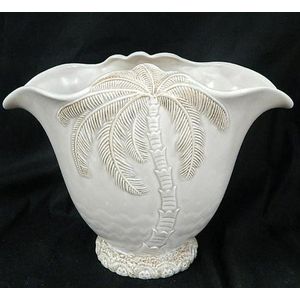Rare Chelsea White Goat and Bee Creamer
A rare soft paste Chelsea white 'Goat and Bee' creamer, circa 1745, incised triangle mark, a waisted bulbous jug moulded with recumbent goats to the base, a bee below the rim, and a twig form handle with applied oak leaves, design attributed to Nicholas Sprimont; mark underside; see Victoria & Albert Museum collection no 2875-1901, height 12 cm
You must be a subscriber, and be logged in to view price and dealer details.
Subscribe Now to view actual auction price for this item
When you subscribe, you have the option of setting the currency in which to display prices to $Au, $US, $NZ or Stg.
This item has been sold, and the description, image and price are for reference purposes only.
- Soft Paste Porcelain - Porcelain is an ancient ceramic material, first made in China, hence the common name "china", and the process was unknown in the West.
European potters attempted to replicate Chinese porcelain, without knowing the ingredients in its composition, and the earliest wares were produced with mixtures of clay and ground-up glass (frit), the idea being that the glass would give the porcelain translucency.
It was given the name "soft" because it did not remain rigid, but "slumped" when fired in the kiln at high temperatures. - Oak - Native to Europe and England, oak has been used for joinery, furniture and building since the beginning of the medieval civilisation. It is a pale yellow in colour when freshly cut and darkens with age to a mid brown colour.
Oak as a furniture timber was superceded by walnut in the 17th century, and in the 18th century by mahogany,
Semi-fossilised bog oak is black in colour, and is found in peat bogs where the trees have fallen and been preserved from decay by the bog. It is used for jewellery and small carved trinkets.
Pollard oak is taken from an oak that has been regularly pollarded, that is the upper branches have been removed at the top of the trunk, result that new branches would appear, and over time the top would become ball-like. . When harvested and sawn, the timber displays a continuous surface of knotty circles. The timber was scarce and expensive and was used in more expensive pieces of furniture in the Regency and Victorian periods. - Circa - A Latin term meaning 'about', often used in the antique trade to give an approximate date for the piece, usually considered to be five years on either side of the circa year. Thus, circa 1900 means the piece was made about 1900, probably between 1895 and 1905. The expression is sometimes abbreviated to c.1900.
- Incised - A record of a name, date or inscription, or a decoration scratched into a surface, usually of a glass or ceramic item with a blunt instrument to make a coarse indentation. Compare with engraving where the surface is cut with a sharp instrument such as a metal needle or rotating tool to achieve a fine indentation.
- Attributed - A cataloguing term where the item in the opinion of the cataloguers, is a of the period of the artist, craftsman or designer, and which probably in whole or part is the work of that person.
This item has been included into following indexes:
Visually similar items

A decorative Beswick Ware vase 23 cm high
Sold by
in
for
You can display prices in $Au, $US, $NZ or Stg.

Belleek milk and sugar (green mark)
Sold by
in
for
You can display prices in $Au, $US, $NZ or Stg.

Sold by
in
for
You can display prices in $Au, $US, $NZ or Stg.

Antique Victorian marble bust a young woman, approx 44 cm high
Sold by
in
for
You can display prices in $Au, $US, $NZ or Stg.
